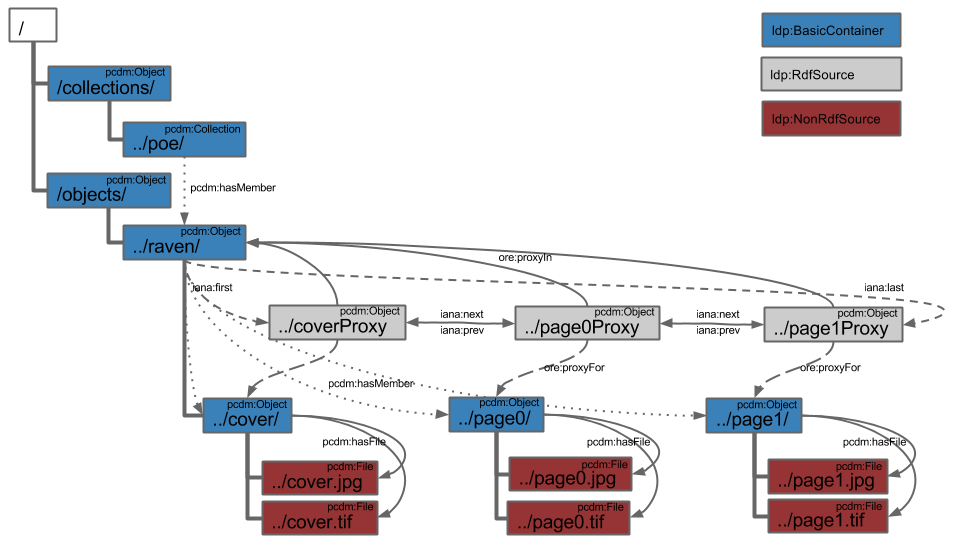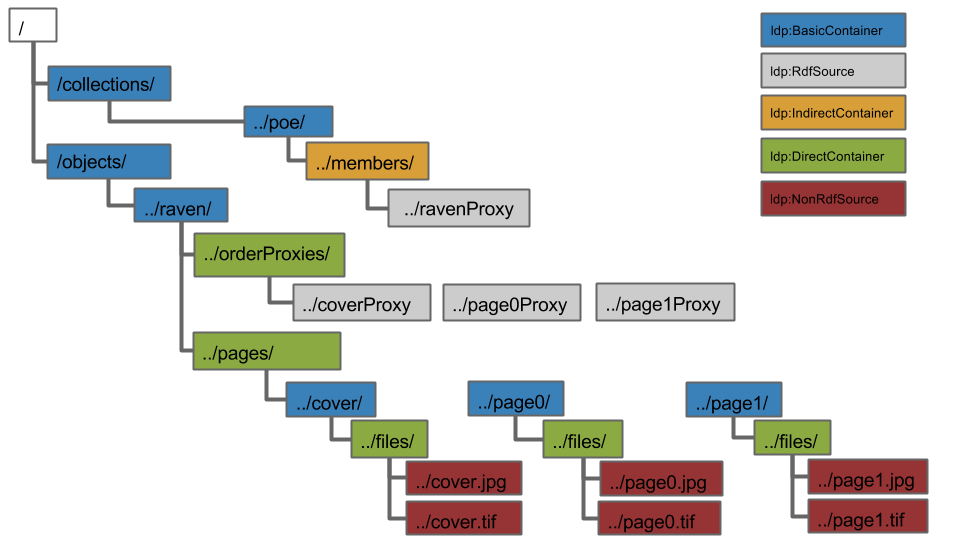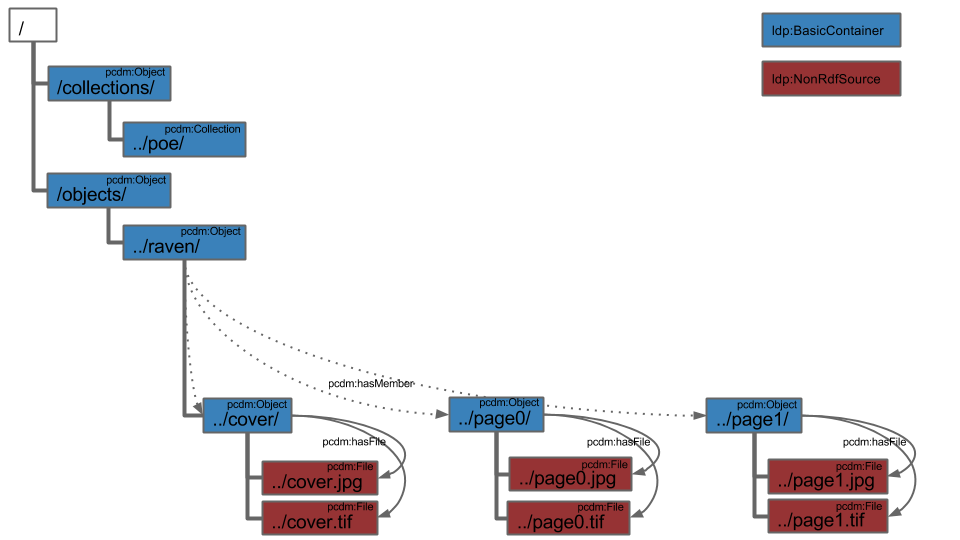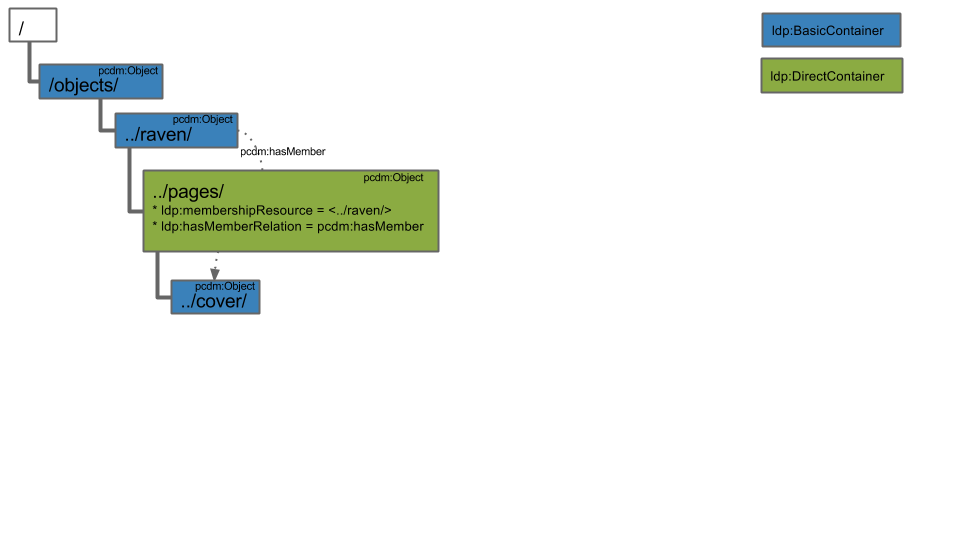| Warning |
|---|
Due to the evolution of usage patterns for PCDM (particularly as they relate to Fedora), the structure of resources described in this guide is not necessarily the recommended structure. -- Andrew Woods 2015-10-30 |
Fedora4 (F4) implements the Linked Data Platform (LDP) W3C Recommendation. Additionally, the Portland Common Data Model (PCDM) has increasingly become adopted as a common content modeling approach in Fedora4.
LDP defines terminology and interaction models relating to linked data resources and servers. The "action" in inter"action" models should be emphasized, because LDP introduces two new concepts that enhance the actions within a linked data server, F4 in this case. These concepts are:
- DirectContainer
- IndirectContainer
These two container types have associated behavior that are highlighted and clarified here, in this guide. Two different uses of DirectContainers are illustrated in the Book and Ordering examples, respectively, and the use of IndirectContainers is described in the Collections example.
This guide is designed to describe the details of both LDP and PCDM in the context of F4 by walking through a simple example of a single collection, consisting of a single book that implements page ordering.
Note0: Although the following example uses specifically named resources, such as "poe" and "raven", production scenarios will likely use opaque identifiers/URLs by allowing them to be auto-generated by F4.
Note1: An easy way to stand-up an environment for executing the following REST requests is to use fcrepo4-vagrant.
Note1a: F4 is deployed in the fcrepo4-vagrant box with the context "fcrepo". If you are deploying in another environment, you may need to change the "curl" requests and turtle files (*.ttl) below to reflect a different context.
Note2: Please use your Internet browser to inspect the results of each of the steps below! http://localhost:8080/fcrepo/rest
The full slide deck of images are available for download.
End Goal - Final State
| Panel | ||||||||
|---|---|---|---|---|---|---|---|---|
| ||||||||
This diagram depicts the logical structure of resources and relationships of a collection ("poe") that consists of a book ("raven") that consists of three pages that are ordered. This is a diagram of the same collection, book, and pages, but depicting the directory structure and LDP resource types. The following steps will walk through the process of creating this structure from the ground up. |
| Panel | ||||
|---|---|---|---|---|
| ||||
The ldp:BasicContainers are simply containers of other resources. BasicContainers can contain both other containers as well as ldp:NonRdfSources (or "binaries"). There are three PCDM types here:
Additionally, there are two PCDM relationships that indicate resource membership and file membership:
The descriptions of these resource types and relationships may be found in the detailed Portland Common Data Model page. |
| Panel | ||||||||||||||||
|---|---|---|---|---|---|---|---|---|---|---|---|---|---|---|---|---|
| ||||||||||||||||
Here we will begin to walk through the mechanics of creating the structures that will facilitate creation of the book and its pages.
Where "pcdm-object.ttl" follows:
Second, create the nested "raven/" pcdm:Object, which is also another ldp:BasicContainer.
Lastly, create an ldp:DirectContainer, "pages/" that will facilitate the establishment of relationships between "raven/" and its constituent pages.
Where "ldp-direct.ttl" follows:
An ldp:DirectContaner is an LDP construct that activates the creation of certain RDF triples when a new resource is added as a child of this container. We will see this in action next! |
| Panel | |||||||||
|---|---|---|---|---|---|---|---|---|---|
| |||||||||
Create a new pcdm:Object, "cover/", that is also an ldp:BasicContainer within the "pages/" DirectContainer.
Where "pcdm-object.ttl" follows:
As described in the previous step, the addition of "cover/" automatically creates the following new triple on "raven/"
Restating from the previous step,
|
| Panel | ||||
|---|---|---|---|---|
| ||||
|
| Include Page | ||||
|---|---|---|---|---|
|
| Include Page | ||||
|---|---|---|---|---|
|
| Include Page | ||||
|---|---|---|---|---|
|
...
| titleBGColor | gray |
|---|---|
| title | 3: Final State - Ordered Pages |
...




